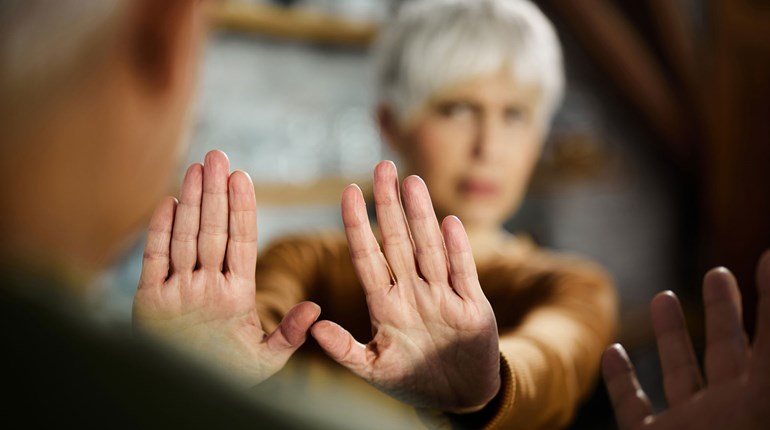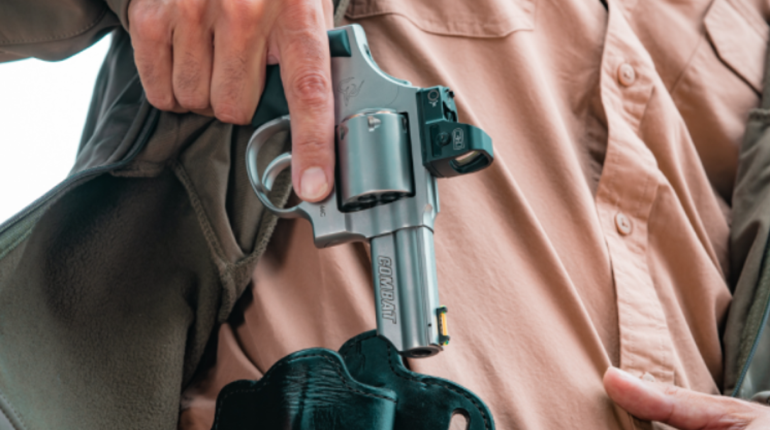
In the hands of a competent practitioner, a tactical pen can be used to distract, deter, delay and even stop a violent physical assault. Unlike your firearm or a folding knife, it is a low-profile, personal-safety option for your toolkit that can be used to help mitigate an active threat.
Plenty has been written about tactical pens, such as the many different styles, building materials and cost, but after selecting your everyday carry (EDC) tactical pen, what are the essential skills you need to know to use it in practical self-defense? The answer is three-fold: carry, access and deployment.

Everyday Carry
If you choose your EDC tactical pen as a viable self-defense option, then the same rules apply to fighting with a tactical pen as they do for a gunfight. Rule number one: carry a tactical pen.
Your next consideration should be where you carry your pen. Do you keep one in your vehicle, on your person or both? If on-body and given your operational or personal profile, consider what is your attire for the day and what real estate may be available on your person for comfortable carry and ready access of your tactical pen.
Certain models are of heavy-duty construction with significant heft, so clipping it in between buttons of a button-down shirt may not work as well for these as it does for their lighter, more streamlined counterparts. A heavier pen would be best structurally supported in any location at or below your belt, such as a pants pocket or inside/outside the waistband. Conversely, it is reasonable to carry a lighter pen in a carry location of your choice above your belt.
Common carry positions include a shirt or pants pocket, clipped to the neckline of an undershirt, in a belt or ankle “holster” or even in your hand, should you perceive an imminent threat.

Ready Access
If you consider your tactical pen to be a threat-response option, it should be made part of your EDC and stored in a comfortable carry position. However, comfort is not the only consideration. An equally important factor in selecting your carry position is accessibility—that is, how quickly can you deploy your rapid-response tool?
Should you intend to make it a viable use-of-force option, then ease of access should be a paramount consideration. Accessibility translates to how quickly you can get your tactical pen into action under extreme duress. The questions you should ask referencing ready access are: Does it take longer than 2 seconds to get the pen in my hand? If so, is there a less restrictive or more expedient way to get the pen in my hand? Consider your day plan. Will you be on foot? Driving? With or protecting others? Such conditions may warrant a different carry and/or access consideration.

Rapid Deployment
In the event of an active human threat intent on causing you death or severe bodily injury, the modern tactical pen may be effectively deployed in such a manner as to create space, which buys you time, which creates more options and opportunity for you to get away.
Operationally speaking, the tactical pen is capable of thrusting, striking, tearing and throwing. Although the mass of your tactical pen may vary, it lends rigidity to a closed fist (referred to as “fist loading,” like a roll of quarters or brass knuckles) for hammer-fist strikes, straight-fist strikes, blocks and parries.
In a life-or-death survival situation warranting use-of-force, the tactical pen can be applied subcutaneously to vulnerable soft-tissue areas such as the eyes, throat and other soft mechanical pressure points, as it is capable of piercing human flesh.
Given dire circumstances, the tactical pen is capable of delivering a lethal strike on the human body commensurate with your level of skill and training. Deployment, in protection of yourself and/or others with you, in a violent physical encounter at close quarters must be rapid, deliberate and without hesitation. Striking quickly and effectively tends to get the attention of an attacker, which in turn buys you needed time to create greater distance from the assailant and additional opportunity to solve the tactical problem.
Getting a Grip
Critical to rapid and effective deployment is how to grip your tactical pen when delivering precision strikes, blocks, parries and takedowns. The tactical pen can be deployed using any one of five easy-to-learn technical grips used in self-defense.
The first and most common is the Forward Hammer Grip, where you hold on to the pen with the point oriented in the forward position (point toward bad guy(s)) with all four fingers wrapped around the thickest part of the pen and your thumb tight over your four fingers much like you would hold a hammer to drive a nail into a wall. Hence the term “Hammer Grip.”
The second most common grip is the Forward Saber Grip, where you hold on to the pen with the point oriented in the forward position (point oriented toward bad guy(s)) with all four fingers wrapped around the thickest part of the pen and your thumb tightly pressing into the top side of the pen your hand making the shape of grasping a saber. Hence the term “Saber Grip.”
Another grip with the pen point oriented forward is the Forward Support Grip, where you have your bottom three fingers wrapped around the thickest part of the pen with your thumb pressing up against the pen on top of your social finger with your index finger alongside the pen pointing forward in the same direction as the point. The advantage of this grip is that it is the most articulate of the three grips and the base of the pen is additionally secured by the palm of your hand.
The next most common is the Reverse Hammer Grip, where you hold on to the pen with the point oriented in the downward position with all four fingers wrapped around the thickest part of the pen and your thumb tight over your four fingers, similar to the Forward Hammer Grip.
The fifth and remaining grip is the Reverse Saber Grip, where you hold on to the pen with the point oriented in the downward position with all four fingers wrapped around the thickest part of the pen and your thumb firmly securing the base of the pen into your hand.
Once you establish any one of these five grips, you will not have time to change grips during a dynamic physical altercation, where you are behind the action-reaction power curve and every tenth of a second matters in response.
Regardless of which grip you choose, the bottom line is you want to hold onto the pen like you’re the third monkey standing on the boarding ramp of Noah’s Ark and it’s starting to rain. If you think you’re holding on tight enough—then increase your grip.

Effective Striking
When things get up close and personal fighting with your tactical pen, you cannot just grip the pen, close your eyes and hope that you land hits. The pen is a limited-range impact weapon and to be used as such you must identify a specific target such as the face, neck and groin.
Once you have identified the target area, you then must maintain an ultra-firm grip and drive the pen directly into the designated target area. What is the shortest distance from one point to another point? Yes, the more direct, the more effective. Like any practical or improvised impact weapon, the more power you can get behind it, the greater the impact. Yet another reason why your grip is so important.
Your tactical pen is not a gun, so you can’t expect the same result from a direct hit. You don’t want to “stay and play” toe-to-toe with your adversaries and continue to fight in place. The idea is to deliver whatever strikes are necessary to get you off that fateful “X” and to a safer place where you have a greater reactionary gap, which buys you more time, which, in turn, affords you more opportunity to find a solution.

Block, Parry, Evade
The bad guy always has the initiative at the start of any tactical engagement because he or they have determined when and where the attack will take place, have determined what weapon(s) they will use and who will be their intended victim(s). Because of this they are in front of the action-reaction power curve and you are forced to react to the initial attack. However, the split second you can cause them to react to you by means of a strike, block, parry or evasion, they are now reacting to your initiative, and that places you in front of the action-reaction power curve.
A block is described as one force vector impacting or meeting against another force vector. Visualize two vehicles moving toward each other. The ensuing impact would be the effect of two force vectors meeting, which mitigates further movement. When applied to an incoming strike, you can use your hand to block and the pen to simultaneously strike.
A parry is described as one force vector redirecting by following behind another force vector. Imagine two vehicles, one chasing behind the other. The ensuing impact of an accelerating follow car would be the effect of one force vector following behind the other that can redirect further movement. When applied to an incoming strike, you can use your hand and the pen simultaneously to parry (redirect) and strike.
An evasion is simply stepping out of the way of an incoming strike or grab. Much like a boxer who moves (bobs or weaves) his head out of the way of an incoming punch, the effect is to not occupy the same space as the incoming object moving toward your head. Your tactical pen can be just as easily applied during an evade as both the block and parry.
If you are deploying your tactical pen in self-defense, it means that you are doing so in fear of death or great bodily harm. You may only have one or two moves in an extremely limited amount of time, so you must make the very best use of that opportunity.
The tactical pen, when used in self-defense, is simply a transitory hand-held tool to help you get off the “X,” and not something that you can rely on to hold your ground indefinitely against one or more attackers until the cavalry arrives. As with any defensive tool, including a firearm, it’s not the “cool of tool” but the user. In other words, its effectiveness resides not in the device itself, but in the skill of the user.
For all its potential uses, the tactical pen has “availability” as its best asset. It can always be there. Small, affordable and innocuous in appearance, it may be the lone defensive tool accessible to you, but with training (and maybe some luck) it could prove handier than a sword.




































